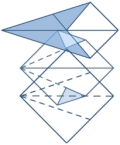Visual FoxPro 9.0 SP2
This page is an addition to the VFP SP2 CHM, covering FFC-supplied reference implementations
of the FX interface for the SP2 Visual
FoxPro Reporting System's FFC FX subsystem.
Back to TMM Index
 About this section
About this section
This section covers various FX and GFX classes included in SP2 as part of the Visual FoxPro Reporting System's FX subsystem. Some classes in this section provide in-the-box extension functionality invoked by the default _REPORT* applications. Others provide useful functionality that must be invoked explicitly by your code.
The SP2 Visual FoxPro Reporting System's Xbase extensions, supplied by the default _REPORT* applications and the FFC classes in the _FRXCURSOR.VCX and _REPORTLISTENER.VCX libraries, includes an implementation of the FX subsystem originally proposed in the RTM help file. This subsystem corresponds to the Visitor design pattern, with a reportlistener (implemented as FXListener in the FFC) triggers members of two collections, FXs and GFXs, to perform various enhancement tasks during a report run.
Because Visual FoxPro does not support interface implementation except from COM object, the FFC specifies the interface required for members of the two collections by supplying an abstract superclass with the appropriate interface: FXAbstract, a Custom-derived class.
FX and GFX collection members are not, however, limited to objects deriving from FXAbstract. The FFC supplies one class supplying in-the-box functionality,FXTherm , deriving from Form.
 In this section
In this section
 See Also
See Also
 About this section
About this sectionThis section covers various FX and GFX classes included in SP2 as part of the Visual FoxPro Reporting System's FX subsystem. Some classes in this section provide in-the-box extension functionality invoked by the default _REPORT* applications. Others provide useful functionality that must be invoked explicitly by your code.
The SP2 Visual FoxPro Reporting System's Xbase extensions, supplied by the default _REPORT* applications and the FFC classes in the _FRXCURSOR.VCX and _REPORTLISTENER.VCX libraries, includes an implementation of the FX subsystem originally proposed in the RTM help file. This subsystem corresponds to the Visitor design pattern, with a reportlistener (implemented as FXListener in the FFC) triggers members of two collections, FXs and GFXs, to perform various enhancement tasks during a report run.
Because Visual FoxPro does not support interface implementation except from COM object, the FFC specifies the interface required for members of the two collections by supplying an abstract superclass with the appropriate interface: FXAbstract, a Custom-derived class.
FX and GFX collection members are not, however, limited to objects deriving from FXAbstract. The FFC supplies one class supplying in-the-box functionality,FXTherm , deriving from Form.
|
|
|---|
| This section does not contain a separate docoid for the FXAbstract class. The simple interface required in the FX subsystem is documented in the SP2 CHM topic on FXListener. Please be sure to refer to the TMM docoid for this class for more important information. |
 In this section
In this sectionThe following classes are FX and GFX implementations includes in the FFC _REPORTLISTENER.VCX library.
| Class | Description |
|---|---|
| FX User Feedback Implementation | FX interface-conformant object derived from Form, providing user feedback during a report run. |
| FX MemberData Script Implementation | Executes script stored in FRX Memberdata, reading it from a cursor in the FRX datasession. |
| FX Group Reset PageTotal | Provides page count & total in any report. Results are similar to system variables _PAGENO & _PAGETOTAL, but accurate in reports that reset _PAGENO on band. |
| GFX Rotation Implementation | Changes default rendering behavior for report layout controls by rotating them according to a MemberData-specified number of degrees. |
| GFX Render-Suppression Implementation | Conditionally eliminates default rendering behavior for report layout controls by evaluating a ReportListener-referencing expression specified in MemberData. |
| GFX Page Region Export | Provides copy-to-image file for designated page regions during a report run, so you can export the rendered regions for embedding in output targets. |
| GFX Collection DataSession-Handling Sample | Example GFX class to show technique the object can use to remove itself from FXListener's collection at the conclusion of a report run. |
 See Also
See Also
